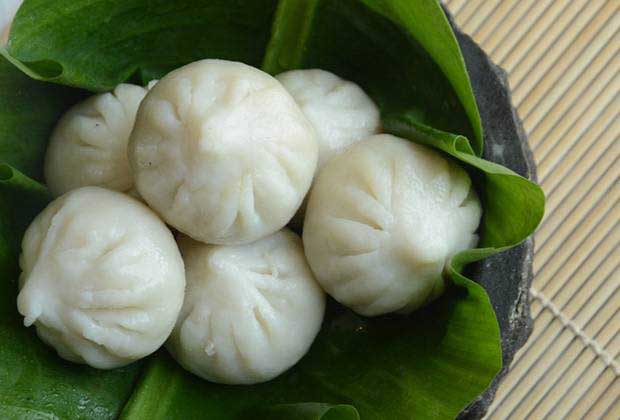What To Eat On A Konkanastha Brahmin Food Trail
- By Shirin MehrotraLoading...
- | 2 May 2016 1:47 PM IST
 X
X
 Ukadiche modaks or steamed sweet dumplings are typically prepared on Ganesh Chaturthi.
Ukadiche modaks or steamed sweet dumplings are typically prepared on Ganesh Chaturthi.
The Konkan region of Maharashtra – a 720 km long coastline with pristine beaches – is home to a number of communities that still stay true to their cuisine. And if you think Konkani food is all about seafood, you’d be surprised. On a recent trip to Guhagar and Diveagar – small coastal villages in the Konkan region – we learnt about the cuisine of the Konkanastha Brahmin community who’ve based their food around the vegetarian produce, despite the abundance of fish.
My first food stop on the trip was Savarkar Bhojanalaya, a vegetarian restaurant near the Ganpati Temple. The meal here was a simple home style thali of usal, tangy aamti, capsicum bhaji cooked with peanuts, pithla – a preparation of besan, bhaat – rice and chapati. The use of wheat – I was told – has been recent and so bhakri made of rice or jowar usually accompanies the meal. Rice panki is also eaten where rice flour batter is spread over banana or turmeric leaves, covered with another leaf and cooked on a pan; the taste is like a cross between a bhakri and neer dosa. The revelation was kaju chi usal – curried preparation of fresh cashews in onions, tomato, fresh coriander and coconut paste and goda masala – the Maharashtrian equivalent of the north Indian garam masala.
Konkani Recipe: How to Make Pithla
The Konkanastha Brahmin cuisine largely depends on the seasonal produce - rice, coconut, sugarcane and mango are the main crops and apart from winters there aren’t many vegetables. Every house has a small vadi or garden in the backyard growing coconut, banana, jackfruit, cashew, mangoes, kokum and betel nut, which makes for a self-sufficient kitchen. Pulses and legumes are grown too, val or field beans being the most common one.
Also Watch: How to Make Kokum Curry
Rice is the staple and so from the main course to dessert, everything is based around it. At Suhas Bapat Khanaval in Diveagar, I saw the fine art of making ukdiche modaks – steamed rice dumplings stuffed with coconut and jaggery mix. The women fold the petals with an expert ease; legend goes that no one can make better modaks than the womenfolk of a Konkanashta Brahmin household. What was also fascinating was that almost all commercial kitchens in this region are run by women.
Festive Recipe: How to Make Ukadiche Modaks
The thali at Suhah Bapat Khanaval comes with val chi usal, aamti, fanas bhaji – jackfruit cooked with coconut, batatya chi bhaji – dry potato subzi, koshimbir – cucumber and curd mix, thecha – green chilli and garlic chutney, chapati, rice and modak. There’s a special dessert too made with hand rolled rice sewai soaked in coconut milk and jaggery mix, which is flavoured with cardamom. Except for the thecha, there’s absolutely no use of onion or garlic. However, the practice is to keep the Jain customers happy. Konkanastha Brahmins cook their food in onion and garlic, but only if the recipe calls for it.
The breakfast at my host Mr Kelkar’s house was the high point of the trip where Mrs Kelkar shared her recipe of pohe – flattened rice and a savoury panchamrut. The community makes various kinds of pohe, the most common one being the kande pohe – the soft savoury pohe cooked with onions and topped with peanuts. The one I had were soaked pohe tempered with mustard seeds, curry leaves and green chillies served with coconut milk, jaggery and tamarind mix. The panchamrut - unlike the regular milk, curd, honey, ghee and tulsi leaves mix – was a savoury concoction of coconut milk, jaggery and tamarind tempered with mustard seeds, curry leaves, green chillies, dry red chillies, curd stuffed dry chillies, cashew, desiccated coconut and ground peanuts among other spices. The result is a robust curry packed with flavours. Spoon it over rice and it’ll beat the best Khow Suey you might have eaten.
Guhagar
Getting there
Guhagar is a 289 km drive from Mumbai via NH66 and there are regular state transport buses available. Volvo buses are available till Chiplun, which is 40 kms from Guhagar. Chiplun is the nearest train station too and you can take a taxi or auto rickshaw to Guhagar.
Getting around
There are regular local buses and auto rickshaws during the day, but better to have your own vehicle if you plan to drive around in the night.
Where to eat
Savarkar Bhojanalaya for a pure vegetarian meal.
Diveagar
Getting there
Diveagar is 180 kms from Mumbai and there are regular state transport buses from Mumbai to Shrivardhan, which is 6 kms from Diveagar.
Getting around
Local buses and auto rickshaws, but having your own vehicle is advisable.
Where to eat
Suhas Bapat Khanawal (09423837967/09271127337) for a typical Konkanashta Brahmin meal. Inform them a few hours in advance and they’ll prepare the meal accordingly.
Kelkar Niwas Gruh for stay and a breakfast of pohe and upma. Inform them a few hours in advance and they’ll prepare the meal accordingly.
Ekvira Khanawal – Potnis Bandhu (092727 22829) if you want to tuck into a lovely fish thali with prawn curry, bhakri and sol kadi. Inform them a couple of hours in advance and they’ll prepare the meal accordingly.
JW Marriott Mumbai Sahar will host a food festival of the Konkanastha Brahmin community from May 6 to 15, 2016.
The author is a freelance food and travel writer and shares her stories on Foodchants. She is on a perpetual quest to learn about the history of regional food.



